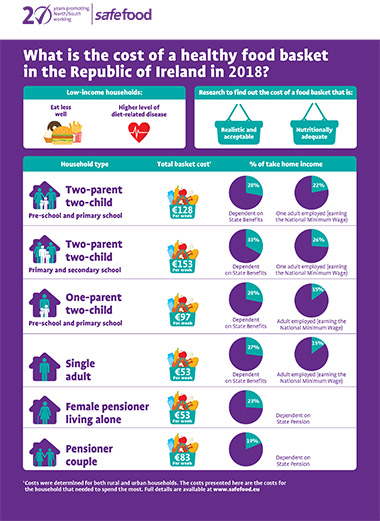
What is the cost of a healthy food basket?

Safefood Ireland, with The Vincentian Partnership for Social Justice, published a report which examined the cost of a healthy food basket for six household types in Ireland. As well as basic food costs, the Healthy Food Basket includes occasional ‘café, take-away, etc.’, and to provide ‘extra for visitors’. This ensures that the social and cultural aspects of food are reflected in healthy food baskets. And so households can participate in activities and practices considered a normal part of everyday life.
A basic healthy food basket
Findings showed some families on low income need to spend up to one third of their income to afford a basic healthy food basket. They found that households with older children must spend significantly more to afford an adequate diet. Rural households also must spend more as it is not always possible to take advantage of deals and offers in larger supermarkets due to transport issues. Households where the only income was from social welfare spent a larger percentage of income on food than those households where one adult is in employment.
The report found that the cost of food has decreased in recent years. We know that the inability to access a healthy diet is a complex issue that incorporates issues of low income, lack of transport and the cost of education, housing and utilities.
“It is sometimes very difficult to cope. We’re doing without anything extra. First I pay the bills and then I use what is left over for the shopping. It can be a nightmare.” (Stories of Struggle, 2018)
It is SVP members’ experience that food is what families on low incomes cut back on when times are tough. This is because it is easier to control than the cost of rent, utilities or education. Rising housing costs means more households are now going without or are being forced to opt for low cost and high calorie food with little or no nutritional value. That’s why approximately one in three calls to SVP are related to food poverty.
“I buy the cheapest food, mostly processed is what I can afford. Once or twice a month I make a big pot of stew. I get the best deals and offers which are often chicken nuggets, burgers and fish fingers. Good food is expensive. I don’t want them to go hungry so I buy what will fill them.” (Stories of Struggle, 2018)
The long-term health and well-being impacts of food poverty cannot be underestimated. Food poverty can result in a poor diet, which is linked to diet-related ill health. It can also impact children’s social, emotional and educational outcomes. When children go to school hungry their well-being, concentration, behaviour, learning and motivation are affected. This has longer term implications for their educational progression and attainment.
“My brother helps me in ways, sometimes. I cook large meals and freeze them. I have a meal plan that gives stability but not variety. When my freezer broke down my brother put our food in his freezer” (Stories of Struggle, 2018)
School Meals and Community Food
The School Meals and Community Food Initiatives can be a key part of the response to food poverty. We also need to look at longer term solutions that tackle the underlying causes of food poverty. These include low income, high living costs and poor service provision in rural and deprived areas.
The Department of Employment Affairs and Social Protection will publish a new National Action Plan for Social Inclusion. It is critical that this plan is ambitious, properly resourced. And deals effectively with the issues of low pay, adequacy of social welfare, and accessibility and affordability of public services. Otherwise, food poverty will continue to impact large sections of Irish society.
